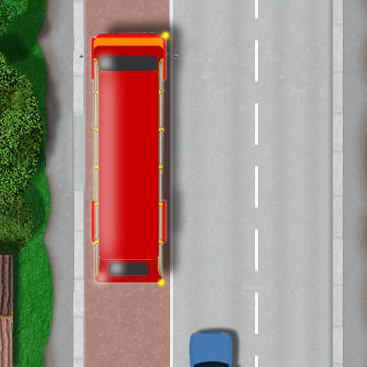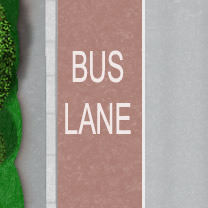Section 2 of 14 of the DVSA driving theory test covers attitude whilst driving. Many accidents happen due to a drivers poor attitude on the road. Good driving required a combination of skills and attitude towards safety.
The questions found in the attitude section of the theory test are based on the differences between good and bad driving attitude. A practice revision quiz can be found towards the bottom of this page. It’s not a mock test but more a revision quiz as the correct answer is provided after each question to help you revise.
Before we take the quiz, we shall cover some of the topics in the ‘Attitude’ category that will important revision for the official DVSA theory test.
Links are provided in this section for further reading but are not required for revising this category.
Manners
Good manners and patience is important when driving. Other drivers may make mistakes, but remain patient and tolerant. Getting aggressive with other road users increases your chances of having an accident and may cause other drivers to drive aggressively. This attitude can result in road rage.
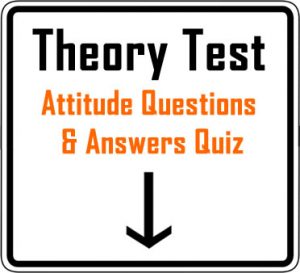
Only flash your lights or use your horn to warn others of danger and avoid using them due to impatience or anger. If you are driving with high beam on, always dip your headlights for approaching vehicles and if you are behind a vehicle. Brake lights can also dazzle drivers behind you when queuing in traffic. In this situation, apply the handbrake to secure the car rather than using the foot brake.
Competitive Driving
Driving competitively should be kept to the race track as this form of driving increases the chances of an accident and of you injuring other road users. Driving too close to other vehicle leaves very little time to react. Driving dangerously close to the vehicle in front is called tailgating.
Following Distances
Following a vehicle too closely can be intimidating and distracting for the driver in front. Remain a safe following distance as this allows for more time to slow down or stop and allows you to see better past the vehicle in front. Many accidents occur due to drivers following a vehicle too closely. A technique that is often used for judging a safe following distance is the 2 second rule – ideal for dry conditions though this is doubled to 4 seconds in wet weather.
Let Other Road User Know Your Intentions
Always correctly signal and in good time when changing lanes or direction such as roundabouts and junctions. This allow traffic to move more smoothly and reduces the potential for accidents.
Giving Priority to Other Vehicles
Emergency vehicles
Emergency vehicles need to move quickly through traffic. You must always move out the way of an emergency vehicle, when safe to do to allow them clear passage. Someone’s life may be depending on them. Police, fire and ambulances use blue flashing lights. Other services such as blood transfusion, bomb disposal, HM coastguard and mountain rescue also use blue lights. Doctors responding to an emergency may use a green flashing light.
Buses
If safe to do so, slow down or stop to give priority to buses wishing to pull out from a bus stop. Bus lanes will often be operational during certain times of the day. Ensure you do not use a bus lane during time of operation which will be displayed on road signs.
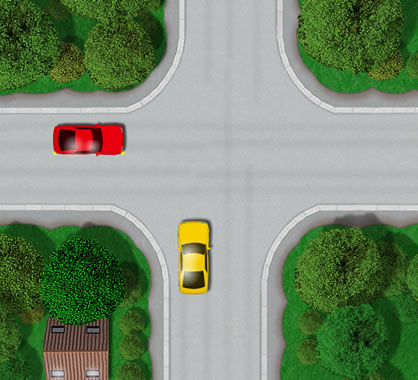
Unmarked crossroads
Unmarked crossroads may be located in quiet areas and have no traffic lights or road markings to dictate who has priority. No one has priority at unmarked crossroads so they must be approached slowly whilst looking in both directions. Only continue through the junction when it is safe to do so. See crossroad junctions for further information.
Attitude Towards Pedestrians
Drivers should be particularly careful in areas of pedestrian crossings. There are four types of pedestrian crossings commonly used on UK roads. White zig zag lines are painted both sides of all pedestrian crossing. It is an offence to park, wait or overtake on any part of the road where the lines are located.
Zebra crossings
Zebra crossings are easily recognised by the black and white stripes painted onto the road surface. To assist drivers in advance warning, continuously flashing lights called Belisha beacons are placed at either end of the crossing.
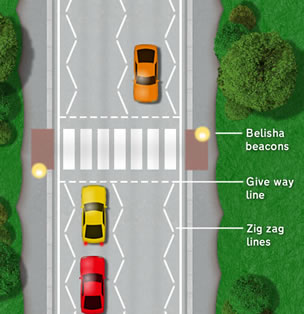
As a driver, look out for pedestrians approaching the crossing from both ends and be prepared to slow down and stop if necessary. Be patient as some pedestrians may cross slowly. Do not encourage pedestrians to cross by waving your hands or flashing your lights as other vehicles may be coming.
Pelican Crossings
Pelican crossings are controlled by traffic signals which are activated by a pedestrian who presses a button. The illuminated red man will turn green informing the pedestrian that they may proceed across the crossing after checking it’s safe to do so. Pelican crossings use a set time to allow pedestrians to cross.
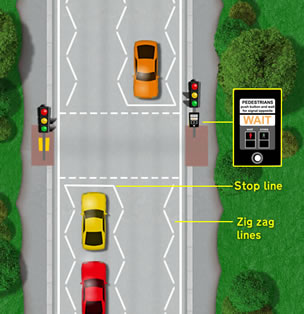
On the approach to a Pelican crossing, look for pedestrians waiting. If they have been waiting for some time, it’s likely the lights will change so be prepared to stop. Pelican crossings use a flashing amber which allows drivers to proceed only if the crossing is clear, but you must give way to pedestrians already on the crossing.
Puffin Crossings
Puffin crossings are similar to Pelican crossings except that they use sensors to establish if pedestrians are waiting to cross. The sensors monitor the crossing and only allow vehicles to proceed once the crossing is clear from pedestrians. Unlike the Pelican, Puffin crossing do not have the flashing amber phase, but rather a steady amber light just like normal traffic lights.
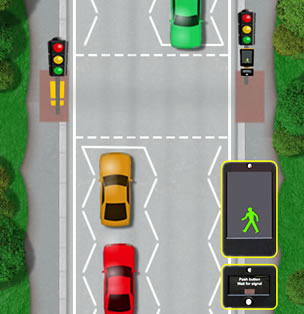
Puffin crossings more beneficial to traffic than the Pelican. If a pedestrian crosses the road quickly, the lights will change allowing traffic to continue as soon as they have crossed. Also, if a pedestrian presses the button and crosses before the lights change, or changes their mind, the lights will not change.
Toucan Crossings
Toucan crossings, easily remembered as ‘two-can-cross’ allows both pedestrians and cyclists to cross simultaneously and without the need for riders to dismount their cycles. Toucan crossings typically function using sensors similarly to that of Puffin crossings.
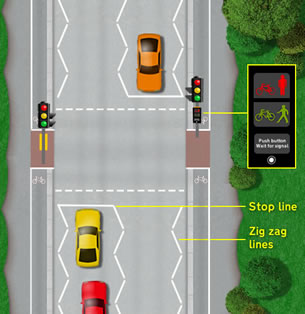
A patient and tolerant attitude should be used around all pedestrian crossings. Anticipation and planning must be used to determine a crossing is up ahead whilst driving and prepare to stop if necessary. Allow pedestrians time to clear the crossing before proceeding.
THEORY TEST Attitude REVISION QUIZ
Take the theory test quiz for the category of ‘Attitude’, which is number 2 of the 14 categories. The quiz provides 12 questions with the answers being provided immediately after you have answered.
Take the theory Test Attitude Practice Revision Quiz
Certain questions may require more than one answer.
Theory Test Categories
- Theory Test Alertness Revision and Test
- Theory Test Documents Revision and Test
- Theory Test Hazard Awareness Revision and Test

